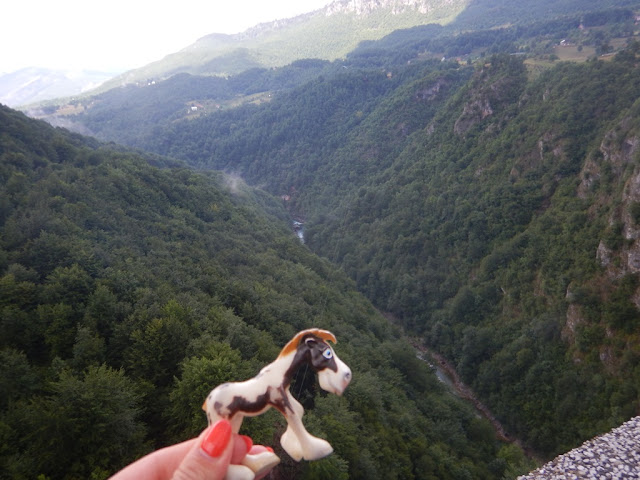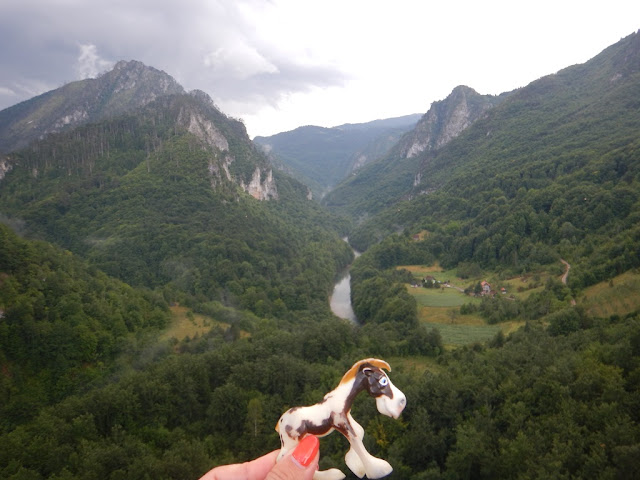We have spent the last few weeks on the Montenegrin Riviera. But today we will say goodbye to sandy beaches and emerald sea.
We will be heading to one of the National Parks of Montenegro. To reach it, we need to pass through mountains. Since Monte-Negro means literally "Black Mountain", I would expect them to be black. But to my surprise, they were green.
Then we need to drive on the shore of Lake Skadar. They say that if you are lucky, you can meet there pelicans.
The Skadar Lake is alimented by river Morača. The river is narrow and shallow.
But what makes it interesting is that it runs in a canyon, which means that it is surrounded on both sides by high hills. And when I say high, I mean it.
In fact, the road is winding together with the river, glued to the steep slope. You will not be surprised to hear that it is considered to be a very dangerous road.
Finally, we reach our destination. The Durmitor National Park.
Its biggest attraction is the canyon of river Tara, the deepest in Europe and second deepest in the world. Just imagine, that this small, shy river has shaped such big mountains.
As we stop to take a break, we can show our admiration to the best alpinist of the region, Dušan Bulatović Džambas.
Time to move again, the biggest attraction is still ahead of us.

I am sure that you are curious to know what this biggest attraction is. Well, it is a bridge.
Does not sound impressive? And if I say this used to be the tallest bridge in Europe? Đurđevića Tara Bridge links to sides of the canyon of the Tara river and is for sure an amazing piece of civil engineering.
No matter if you look on the left ...
... or on the right, it is almost hard to notice the river itself. I even start to wonder if it was really needed to build an entire bridge over it.
It is by looking down from the bridge that one realises that it is maybe not that small. And that building a lower bridge was not real an option. At least until humans invent lorries that can go up the hill. Horizontally.
Obviously, humans have invented a smarter way to move over Tara river. They call it a zip line. No one will ever convince me that human beings are fully sane. No horse would ever try to ride on a thin line over a canyon.
I hope that now you understand why Durmitor National Park has joined the UNESCO World Heritage List. It is indeed one of a kind.
We will be heading to one of the National Parks of Montenegro. To reach it, we need to pass through mountains. Since Monte-Negro means literally "Black Mountain", I would expect them to be black. But to my surprise, they were green.
Then we need to drive on the shore of Lake Skadar. They say that if you are lucky, you can meet there pelicans.
The Skadar Lake is alimented by river Morača. The river is narrow and shallow.
But what makes it interesting is that it runs in a canyon, which means that it is surrounded on both sides by high hills. And when I say high, I mean it.
In fact, the road is winding together with the river, glued to the steep slope. You will not be surprised to hear that it is considered to be a very dangerous road.
Finally, we reach our destination. The Durmitor National Park.
Its biggest attraction is the canyon of river Tara, the deepest in Europe and second deepest in the world. Just imagine, that this small, shy river has shaped such big mountains.
As we stop to take a break, we can show our admiration to the best alpinist of the region, Dušan Bulatović Džambas.
Time to move again, the biggest attraction is still ahead of us.

I am sure that you are curious to know what this biggest attraction is. Well, it is a bridge.
Does not sound impressive? And if I say this used to be the tallest bridge in Europe? Đurđevića Tara Bridge links to sides of the canyon of the Tara river and is for sure an amazing piece of civil engineering.
No matter if you look on the left ...
... or on the right, it is almost hard to notice the river itself. I even start to wonder if it was really needed to build an entire bridge over it.
It is by looking down from the bridge that one realises that it is maybe not that small. And that building a lower bridge was not real an option. At least until humans invent lorries that can go up the hill. Horizontally.
Obviously, humans have invented a smarter way to move over Tara river. They call it a zip line. No one will ever convince me that human beings are fully sane. No horse would ever try to ride on a thin line over a canyon.
I hope that now you understand why Durmitor National Park has joined the UNESCO World Heritage List. It is indeed one of a kind.





















































